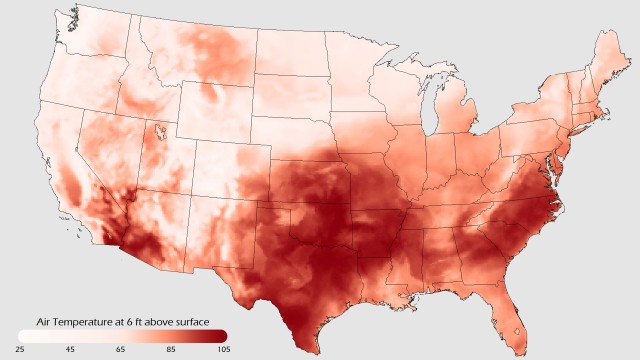Welcome to DU!
The truly grassroots left-of-center political community where regular people, not algorithms, drive the discussions and set the standards.
Join the community:
Create a free account
Support DU (and get rid of ads!):
Become a Star Member
Latest Breaking News
General Discussion
The DU Lounge
All Forums
Issue Forums
Culture Forums
Alliance Forums
Region Forums
Support Forums
Help & Search
Environment & Energy
Related: About this forumWarm extremes in Earth’s climate becoming more common

The drought and heat wave of 2011, an example of an extreme event
When you see a lot of sixes coming up on a friend’s Monopoly dice, you might begin to harbor a suspicion that the dice are loaded. But if you see sevens appear, you know something is definitely amiss.
Many scientists have used the analogy of loaded dice when they talk about how weather extremes would change in a warming climate, where the loading of the dice would become apparent over time. So, were recent extreme events like the suffocating 2010 Moscow heat wave or the 2011 Texas drought the product of loaded climate dice?
The immediate cause of each was a meteorological event, such as the “blocking high” that kept the hot weather over Moscow for so long. However, a new study led by NASA’s James Hansen argues that “we can say with high confidence that such extreme anomalies would not have occurred in the absence of global warming.” These basic meteorological events are not uncommon, the study says, but the extreme aspects were made possible by the underlying climate.
The conclusion comes from an analysis of how climate variability has changed since the 1950s. The analysis focuses on the Northern Hemisphere summer months of June, July, and August. This is partly because the winter season is inherently more variable (which makes it harder to detect changes), and partly because longer and warmer summers lead to the kind of extreme droughts and heat waves that have major impacts. (The Northern Hemisphere summer also covers a much larger land mass, where seasonal swings are large, than does the Southern Hemisphere summer.)
http://arstechnica.com/science/2012/08/warm-extremes-in-earths-climate-becoming-more-common/
InfoView thread info, including edit history
TrashPut this thread in your Trash Can (My DU » Trash Can)
BookmarkAdd this thread to your Bookmarks (My DU » Bookmarks)
2 replies, 900 views
ShareGet links to this post and/or share on social media
AlertAlert this post for a rule violation
PowersThere are no powers you can use on this post
EditCannot edit other people's posts
ReplyReply to this post
EditCannot edit other people's posts
Rec (2)
ReplyReply to this post
2 replies
 = new reply since forum marked as read
Highlight:
NoneDon't highlight anything
5 newestHighlight 5 most recent replies
= new reply since forum marked as read
Highlight:
NoneDon't highlight anything
5 newestHighlight 5 most recent replies
Warm extremes in Earth’s climate becoming more common (Original Post)
DainBramaged
Aug 2012
OP
phantom power
(25,966 posts)1. We even have a branch of statistics dedicated to questions like this:
If you encounter an 'extreme' value (generally, a new maximum or minimum in your sample stream), you can assess the probability that this new value would occur, under various conditions. It's pretty helpful for anomaly detection algorithms, and testing for non-stationary distributions. Testing for climate change is one particular example of 'testing for non-stationary distributions'
Extreme value theory or extreme value analysis (EVA) is a branch of statistics dealing with the extreme deviations from the median of probability distributions. It seeks to assess, from a given ordered sample of a given random variable, the probability of events that are more extreme than any observed prior. Extreme value analysis is widely used in many disciplines, ranging from structural engineering, finance, earth sciences, traffic prediction, geological engineering, etc
http://en.wikipedia.org/wiki/Extreme_value_theory
http://en.wikipedia.org/wiki/Extreme_value_theory
DainBramaged
(39,191 posts)2. We are on a path to most of the US becoming Miami